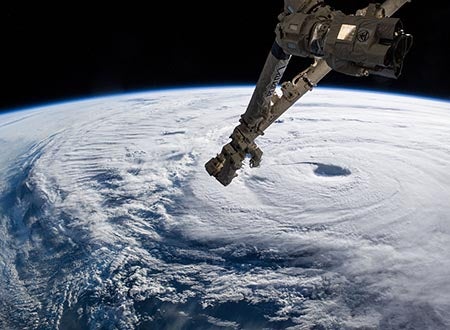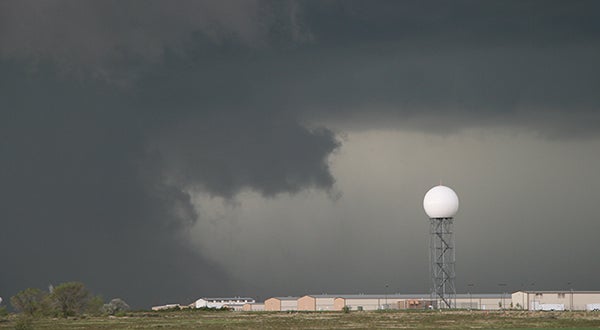A global look at forecasting's future
NCAR/UCAR experts to join unique world weather conference
Jul 10, 2014 - by Staff
The NSF NCAR Mesa Lab will be closed Thursday, Dec. 18, and Friday, Dec. 19, due to extreme winds and power outages.
View more information.Jul 10, 2014 - by Staff
July 10, 2014 | More than 1,000 forecasters, researchers, and other professionals from around the globe will convene in Montréal on August 16–21 for a first-of-a-kind meeting aimed at pooling international thought on where weather prediction is headed. NCAR and UCAR participants are on tap to cover a wide range of promising developments.

Aboard the International Space Station, a flight engineer from the European Space Agency captured this view of Typhoon Neoguri as it spun across the northwest Pacific Ocean on July 7, 2014. Although Neoguri's path was fairly well predicted, the powerful storm weakened more rapidly than expected before it raked eastern Japan on July 10. The unexplained "crack" extending leftward from the top of Neoguri's eye in this image has intrigued meteorologists. Tropical cyclones, including hurricanes and typhoons, are one of the major weather threats to be discussed at the World Weather Open Science Conference. (Image courtesy NASA.)
The World Weather Open Science Conference (WWOSC) will examine the latest scientific advances and discuss how the benefits of this knowledge can best be used for the good of society. The meeting’s co-organizers are the World Meteorological Organization, the International Council for Science, Environment Canada, and Canada’s National Research Council. NCAR and UCAR are among the meeting’s official sponsors.
While a number of regular conferences explore meteorological progress, this one is the first to bring together participants from around the world across the spectrum of weather-related specialties, including research, technology, forecasting, and stakeholders sensitive to weather impacts.
“What makes this conference different is that it brings together diverse research communities that usually meet separately. This will allow us to address all aspects of understanding, predicting, and responding to weather,” said NCAR director James Hurrell, who is part of the 15-member scientific organizing committee for the WWOSC. “Having this broad a spectrum of people together at one event will help us identify the biggest challenges and the most critical needs in weather prediction.”
UCAR president Thomas Bogdan will take part in a panel discussion on the future of the weather enterprise, a term that includes the academic, government, and industry elements. “If we are serious about saving lives and livelihoods,” said Bogdan, “we must invest our shared resources and expertise so that decision makers are better equipped to make the right decisions at the right times.”
Below is a sampling of the topics to be covered by NCAR and UCAR presenters during the WWOSC. More-detailed programs can be found on the WWOSC website, which is available in English and French.

A severe thunderstorm on May 21 looms near a NEXRAD radar located at Front Range Airport northeast of Denver. The storm's heavy hail and high winds forced closure of the nearby Denver International Airport. Severe thunderstorms during May 20-22 resulted in more than $100 million in insurance claims across Colorado, largely related to hail damage. (Photo by Bob Henson, UCAR.)